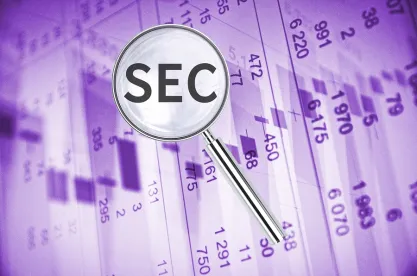On November 17, 2020, the U.S. Securities and Exchange Commission (“SEC”) announced it had adopted amendments to Regulation S-T and other rules to permit the use of electronic signatures for SEC filings (the “Amendments”). Under the Amendments, companies may use an electronic signature provider, such as DocuSign or Adobe Sign, to obtain signatures for documents that they file with the SEC, and avoid having to obtain and retain paper originals of the signature pages. However, companies must ensure that the signing process meets certain minimum requirements discussed below.
The following are some key action items for public companies, registered investment companies, and business development companies that desire to use electronic signatures for SEC filings:
-
Review their existing policies and procedures for electronic filings to ensure that they comply with current requirements.
-
Amend their policies and procedures for electronic filings to comply with the electronic filing requirements discussed below.
-
Have each director and officer that signs SEC filings manually execute a document attesting that such individual agrees that the use of an electronic signature in any authentication document constitutes the legal equivalent of such individual’s manual signature for purposes of authenticating the signature to any filing for which it is provided (an “initial electronic signature authentication document”).
Effective Date
The Amendments became effective December 4, 2020. The SEC staff had also provided guidance that permitted early compliance with the new rules.
Amendments to Rule 302(b)
Prior to the Amendments, Rule 302(b) of Regulation S-T required that each signatory to an electronic filing manually sign a signature page or other document (an “authentication document”) before or at the time of the electronic filing to authenticate, acknowledge, or otherwise adopt the signature that appears in typed form within the electronic filing. As a result, companies were required to obtain wet ink or manual signatures for all electronic submissions that required signatures. Even if a signatory executed a signature page and provided a photograph or PDF copy to the company to authorize filing, a company was required to obtain the original, manual signed signature page for its records.
The Amendments modify Rule 302(b) to allow a signatory to electronically sign an authentication document, provided that an initial electronic signature authentication document is obtained and that the process for electronic signatures discussed below is followed. While manual signatures on authentication documents are still permitted, use of an electronic signature eliminates the need to obtain and retain original, manual signed signature pages. Before using an electronic signature for an SEC filing, a signatory must manually sign a document attesting that the signatory agrees that the use of an electronic signature in any authentication document constitutes the legal equivalent of such individual’s manual signature.
The existing requirement of Rule 302(b) that a company must retain an authentication document for a period of five years remains unchanged, although it now applies whether the authentication document is signed manually or electronically. The record retention requirement for an initial electronic signature authentication document is longer - a company must retain an initial electronic signature authentication document for as long as the electronic signature is used and for a minimum of seven years after the date of the most recent electronically signed authentication document. However, a company may now retain and store both authentication documents (whether manually or electronically signed) and initial electronic signature authentication documents via electronic means (i.e., the original wet ink signature does not need to be retained). The existing requirement of Rule 302(b) for a company to furnish to the SEC or its staff upon request an authentication document also now applies to an initial electronic signature authentication document.
Process for Electronic Signatures
The requirements for the electronic signature signing process are set forth in the Electronic Data Gathering, Analysis, and Retrieval system (“EDGAR”) Filer Manual, which specifies that, when a signatory signs an authentication document using an electronic signature, the signing process must, at a minimum:
-
Require the signatory to present a physical, logical, or digital credential that authenticates the signatory’s individual identity;
-
Reasonably provide for non-repudiation of the signature;
-
Provide that the signature be attached, affixed, or otherwise logically associated with the signature page or document being signed; and
-
Include a timestamp to record the date and time of the signature.
The SEC noted in the adopting release that the requirement that the signature be logically associated with the signature page or the document being signed means the signatory will be provided with notice of the nature and substance of the document and an opportunity to review it before signing, and that the electronic signature will be linked to the signature page or document in a manner that allows for later confirmation the signatory signed the signature page or document before or at the time an electronic filing is made. As the authentication document must be executed before or at the time an electronic filing is made, the signing process must include a timestamp that records the date and time of the electronic signature.
The EDGAR Filer Manual defines the following terms:
-
An “electronic signature” is an electronic sound, symbol, or process, attached to or logically associated with a record and executed or adopted by a person with the intent to sign the record.
-
A “credential” is an object or data structure exclusively possessed and controlled by an individual to assert identity and provide for authentication.
-
“Non-repudiation” is assurance that an individual cannot falsely deny having performed a particular action.
The SEC noted that these signing process requirements are intended to be technologically neutral and allow for different types and forms of electronic signatures. It appears clear that leading electronic signature providers, including DocuSign and Adobe Sign, will satisfy such requirements.
* * *
The following chart shows the key SEC filings for which electronic signatures are permitted after the Amendments:
|
Securities Act of 1933 |
Form S-1 |
|
Securities Exchange Act of 1934 |
Form 10 |
|
Investment Company Act of 1940 |
Form N-1A |






 />i
/>i

